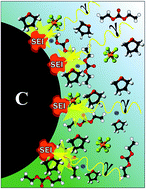Ex situ solid electrolyte interphase synthesis via radiolysis of Li-ion battery anode–electrolyte system for improved coulombic efficiency†
Abstract
The radiolysis of a mixed solvent electrolyte–carbon anode material is investigated for the first time. The present work demonstrates the radiolytic growth of an SEI with a chemical composition similar to that formed during electrochemical cycling, as determined by XPS. The quantity of the SEI increases with increasing irradiation dose. Degradation products formed in the liquid and gas phase are also identified as matching those formed during electrochemical cycling. TEM results support the XPS results of increasing SEI content with increasing irradiation dose. Electrochemical characterization by galvanostatic cycling of test cells indicates that the radiolysis generated SEI greatly improves first cycle efficiency of the materials assembled in half cells, and impedance spectroscopy supports the result with an increase in resistivity observed for irradiated samples. This first study opens the door to the use of irradiation tools for the artificial generation of an SEI and for producing LIB anode materials with improved performance.



 Please wait while we load your content...
Please wait while we load your content...